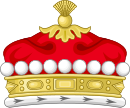| Viscountcy of Hill | |
|---|---|
  Blazon
| |
| Creation date | 1842 |
| Created by | Queen Victoria |
| Peerage | Peerage of United Kingdom |
| First holder | Rowland Hill, 1st Viscount Hill |
| Present holder | (Peter) David Raymond Charles Clegg-Hill, 9th Viscount Hill |
| Heir apparent | Hon. Michael Charles David Clegg-Hill |
| Subsidiary titles | Baron Hill Baronet Clegg-Hill of Hawkestone |
| Status | Extant |
| Former seat(s) | Hawkstone Hall |
| Motto | ADVANCEZ Forward |

Viscount Hill, of Hawkstone and of Hardwicke in the County of Salop, is a title in the Peerage of the United Kingdom. It was created in 1842 for General Rowland Hill. He had already been created Baron Hill, of Almaraz and of Hawkstone in the County of Salop, in 1814, with remainder to the heirs male of his body, and Baron Hill, of Almarez and of Hawkestone and Hardwicke in the County of Salop, in 1816, with remainder to the heirs male of his elder brother John Hill. The viscountcy was created with the same special remainder. On the first Viscount's death in 1842, the barony of 1814 became extinct as he had no male issue, while he was succeeded in the barony of 1816 and the viscountcy according to the special remainders by his nephew Sir Rowland Hill, 4th Baronet. His son, the 3rd Viscount, sat as a Conservative Member of Parliament for Shropshire North. In 1875, he assumed by royal licence the additional surname of Clegg, which was that of his maternal grandfather. He inherited financial problems from his father which led to the breakup and sale of the family estates.
Contents
- Hill, later Clegg-Hill baronets of Hawkestone (1727)
- Baron Hill, First Creation (1814)
- Viscount Hill (1842) and Baron Hill, Second Creation (1816)
- See also
- References
- Work cited
- External links
The Hill, later Clegg-Hill baronetcy, of Hawkestone in the County of Shropshire, was created in the Baronetage of Great Britain in 1727 for the first Viscount's grandfather Rowland Hill, with remainder to his cousins Samuel Hill, of Shenstone, Thomas Hill, of Tern (whose eldest son Noel Hill was created Baron Berwick in 1784) and Rowland Hill, brother of Thomas. The baronetcy was created in honour of Rowland Hill's uncle, the diplomat and statesman the Rev. and Hon. Richard Hill of Hawkstone (1655–1727). Sir Rowland Hill later represented Lichfield in Parliament. His son, Sir Richard Hill, 2nd Baronet, represented Shropshire. He was succeeded by his younger brother, the third Baronet. He sat as a Member of Parliament for Shrewsbury. His grandson, the fourth Baronet, represented Shropshire and Shropshire North as a Tory, before he succeeded his uncle in the barony and viscountcy of Hill. He later served as Lord Lieutenant of Shropshire. He married Anne Clegg heiress of Peplow Hall in 1831.
A boarding house at Wellington College, Berkshire was named after the first Viscount around the time of the school's construction in the 1850s.
The family seat was Hawkstone Hall, near Market Drayton, Shropshire.
